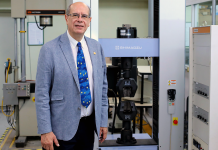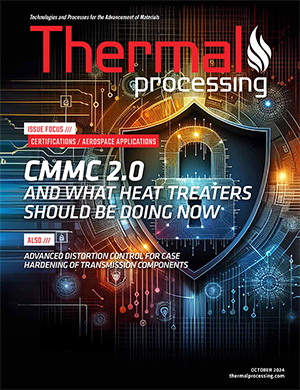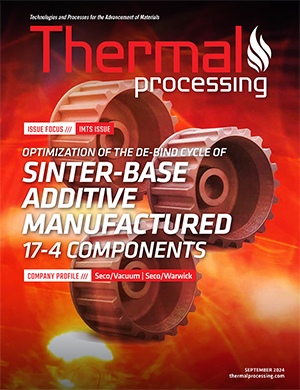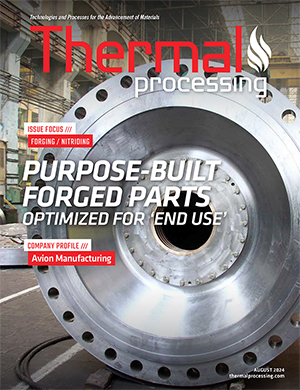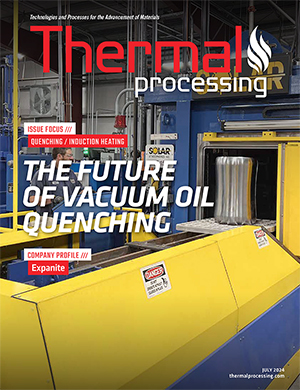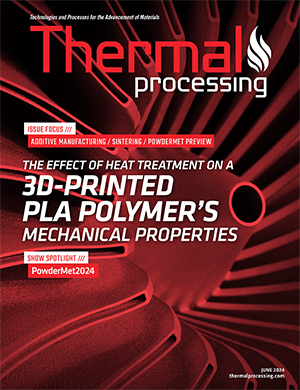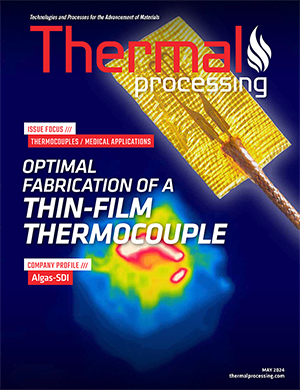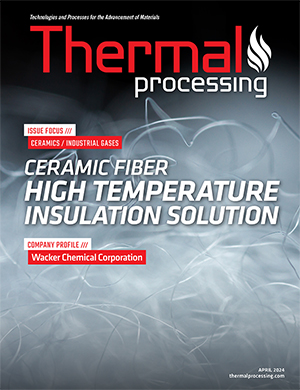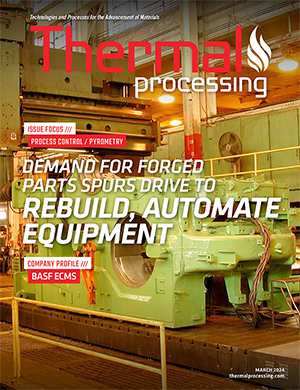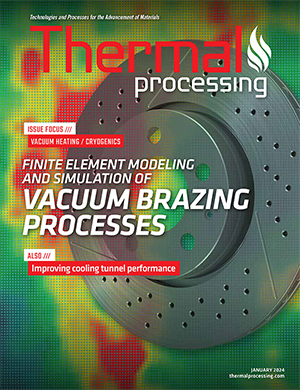Archives
October 2024
CMMC 2.0 and what heat treaters should be doing now
The heat-treating industry, while traditionally focused on metallurgical and heat-treating processes, has increasingly become integrated with the digital world. As a critical component in the supply chains of defense, aerospace, and other high-tech industries, heat treaters have now become custodians of sensitive and controlled unclassified information (CUI). With the Cybersecurity Maturity Model Certification (CMMC) 2.0 […]
Homogenization heat treatment influence on microstructure evolution and mechanical properties for an alloy used in lightweight aerospace applications
Al–Li–Cu–Mg–Zr alloys are widely used in the aerospace industry for different applications and make an excellent concurrent to high-performance composites. This family of alloys has remarkable properties such as low density, high elastic modulus, high strength and specific stiffness, fracture toughness, fatigue crack growth resistance, and improved corrosion resistance. The present work aims to investigate […]
Advanced distortion control for case hardening of transmission components
In many applications the high demands regarding fatigue properties of transmission components can be reached only by the application of customized case hardening. This case-hardening process results in a wear resistant surface layer in combination with a tough core. However, as a side effect, the components get distorted during heat treatment. This distortion has a […]
September 2024
Optimization of the de-bind cycle of sinter-base additive manufactured 17-4 components
Sinter-based additive manufacturing (S-BAM), of which Binder Jet AM (BJAM) is one approach, is quickly becoming recognized as one of the most desirable methods to produce high-volume 3D printed components and to develop new 3D printable materials. Although the S-BAM technique of printing has been available for a while, the optimal processing parameters, such as […]
Heat treatment in the manufacturing of composites
When it comes to composite manufacturing, thermal and heat treatment is a critical process that has a significant influence on the result of the final product. Industrial heat treatment, also referred to as thermal processing, involves controlled heating and cooling cycles designed to enhance and develop essential qualities in composite materials. The heat-treatment process is […]
Embracing the digital transformation: Maximizing efficiency and predictive maintenance
The heat-treatment industry is essential to global manufacturing. The volatile, uncertain, complex, ambiguous (VUCA) landscape of the industry has led to many changes over time. In the 1980s, globalization was the focus, while in the 1990s, automation came to the fore. Moving into the 2000s and ongoing, energy transition was yet another factor for the […]
August 2024
Purpose-built forged parts optimized for ‘end use’
When forging seamless rolled rings for diverse sectors such as industrial machinery, pulp and paper, turbines, and oil and gas exploration, it is crucial to tailor components for their specific applications or “end use.” In the realm of metal parts, this term commonly denotes the ultimate form and state of the final machined part, along […]
Nitriding of hardfaced layers as a method of improving wear resistance of hot forging tools
This article deals with novel hybrid layers combining hardfacing and nitriding to improve forging tool durability. It includes a study of the nitriding capabilities of hardfacings made of typical materials used to repair key groups of hot forging tools. Tests were conducted on samples and on tools in forging processes. Tests on samples included hardfacing, […]
How to unlock time and profit savings with data
In the highly specialized world of commercial heat treating, precision, efficiency, and data-driven decision-making are critical for success. Capturing and using accurate data can significantly improve operations, profitability, and customer satisfaction. In this article, we will cover: The essential types of data that commercial heat treaters need to capture. The transformative power of that data. […]
July 2024
The future of vacuum oil quenching
Despite decades of relentless innovation, the constraints of high-pressure gas quenching have become increasingly evident. Even with the utilization of specialized inert gas blends and heightened gas pressures, the gas cooling efficacy compared to liquid quenchant cooling particularly for heavier cross sections has its limitations. It is also undeniable that certain aerospace alloy steels governed […]
Nitrogen gas quenching pressure effect on BS S155 alloy steel in a vacuum furnace
The production of metal and alloy products requires the use of heat treatment. During the heat-treatment process, quenching is a crucial step. The quenching medium can be anything from water, a salt bath, oil, air, or gas. In a vacuum furnace, pressurized gas, most frequently nitrogen (N2) gas, serves as one of the quenching media. […]
Carburizing steel mechanical properties
This article is a follow-up to the three articles on “Mechanical Properties of Carburized Steel” in the March [1], April [2], and May [3] 2023, issues of Thermal Processing. In the March article, it was shown the carburized case by itself is not as strong as predicted by the hardness, and that it fractures with […]
June 2024
The effect of heat treatment on a 3D-printed PLA polymer’s mechanical properties
Three-dimensional printing is a useful and common process in additive manufacturing. The advantage of additive polymer technology is its rapidity and design freedom. Polymer materials’ mechanical properties depend on the process parameters and the chemical composition of the polymer used. Mechanical properties are very important in product applicability. The mechanical properties of polymers can be […]
Effects of the sintering process on Al2O3 composite ceramics
The sintering process can improve the microstructure of Al2O3 composite ceramics and enhance their comprehensive properties, but the effects of the sintering process on Al2O3 composite ceramics are still unclear. Herein, a novel Al2O3 composite ceramic was printed using the material extrusion and photo-polymerization combined process, and the final ceramic was obtained using one-step sintering […]
May 2024
Optimal fabrication of a thin-film thermocouple using Alumel/Chromel junctions
Thin-film thermocouple (TFTC) technology is a novel measurement method that produces a thermocouple sensor during the deposition process, even though it is a complex surface, to obtain the surface temperature. TFTC is a thin film sensor for measuring temperature by contact methods, consisting of two different metals that can generate thermoelectric forces named “Seebeck effects.” […]
Reducing time and cost of heat treatment post-processing of AM Ti6Al4V
The unique microstructure of Ti6Al4V produced through laser powder bed fusion (LPBF) displays high-tensile strength with low elongation in the as-built state. To obtain desired material properties that comply with standards for Ti6Al4V products, further post-processing is needed. Conventional practice prescribes that the required tensile properties can be achieved with time-consuming post-processing heat treatment of […]
April 2024
Ceramic fiber: High temperature insulation solution
Ceramic fiber is essential in various industries involving high-temperature operations. It offers superior thermal resistance for protecting structures, equipment, and machinery from steel and glass production to airplane and space vehicle manufacture. What is high temperature ceramic fiber? Ceramic fibers are synthetic materials comprised of small filaments made from high-purity aluminosilicate minerals. Thanks to their […]
Nitrogen gas quenching pressure effect on BS S155 alloy steel in vacuum furnace
The production of metal and alloy products requires the use of heat treatment. During the heat-treatment process, quenching is a crucial step. The quenching medium can be anything from water, a salt bath, oil, air and gas. In a vacuum furnace, pressurized gas, most frequently nitrogen (N2) gas, serves as one of the quenching mediums. […]
The role of photo chemical etching in thermal management
The photochemical etching (PCE) process is distinguished by its capacity to fabricate metal parts with unparalleled accuracy. This process sidesteps the typical stresses and deformations linked to conventional metalworking, such as stamping or laser cutting, which can compromise material integrity. Such fidelity is crucial in the manufacture of components for thermal management systems, where material […]
March 2024
Demand for forged parts spurs drive to rebuild, automate equipment
Today, global demand for rebuilt forging equipment is surging, driven in part by a dramatic rise in the need for military ordnance spurred by Russia’s invasion of Ukraine. As in past wars and conflicts, the demand for forged parts often increases as governments seek to replenish depleted stocks of artillery shells, tanks, aircraft parts, and […]
Experimental validation of high-spatial resolution of two-color optical fiber pyrometer
Taking non-contact temperature measurements in narrow areas or confined spaces of non-uniform surfaces requires high spatial resolution and independence of emissivity uncertainties that conventional cameras can hardly provide. Two-color optical fiber (OF) pyrometers based on standard single-mode (SMF) and multi-mode optical fibers (MMF) with a small core diameter and low numerical aperture in combination with […]
February 2024
Insulation paper: Exploring a versatile thermal solution
Insulation paper is a thin, flexible, high-temperature material used in industrial processing applications where heat management is critical. It provides thermal protection up to 3,000°F (1,600°C) and is easily adaptable to complex equipment geometries. With versatility, durability, and excellent thermal performance, insulation paper becomes an ideal insulation solution for furnaces, boilers, heat exchangers, automotive parts, […]
Experimental research of a small-scale industrial furnace with regenerative disc-flame burners
Regenerative combustion technology has many advantages such as fuel saving, high combustion efficiency and low emission, and it has been widely used for large-scale furnaces. However, when regenerative combustion technology is adopted for small-scale furnaces, many technical problems occur. In this article, a small-scale regenerative furnace with a heat load of 70-80 kW and primary […]
January 2024
Finite element modeling and simulation of vacuum brazing processes
Vacuum brazing is a black box process, so component distortion that occurs during heat treatment is difficult to prove experimentally. Thus, a novel FE-model was developed in ANSYS Workbench to calculate the time and location resolved component deformation of AISI 316L/B-Ni2 brazing assemblies. In this regard, a new method of radiation and contact modeling was […]
Case study: Improving cooling tunnel performance
The Mt. Holly, South Carolina, smelting facility of global producer Century Aluminum houses casting equipment to process nearly 230,000 metric tons of material into standard-grade ingot, HDC ingot, extrusion billet, and other products. As the first primary aluminum plant in the world to achieve the ISO 9001 Quality System Standard, Mt. Holly has the highest […]
Reimagining the steel production process
Steel has a major impact on everyone’s lives and our economy. It is crucial to cars, trucks, airplanes, buildings, and more. However, there is a significant issue with its production process. Globally, it accounts for a large percentage of greenhouse gas emissions from the industrial sector. The U.S. Department of Energy (DOE) recently announced $19 […]


